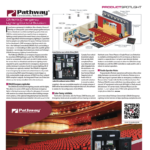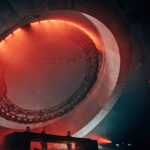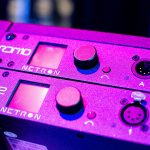Tracing the Evolution of HES’ MMS Orbital Head: A look at moving mirror systems technologies offered by High End Systems, a Barco Company
Rather than struggle with the challenge of rigging and precisely pointing the beam from a big, bulky projector, it’s often easier and more efficient to fine-tune the position of a flat mirror that reflects and angles the light beam. That simple truth has led to the creation of MMS (moving mirror system) technologies by Austin, Texas-based High End Systems, now owned by Barco. Here, PLSN takes a closer look at the MMS concept and how it evolved.
What is the MMS?
DMX controlled, moving mirror head mounted on front of a projector used to position a projected image anywhere.
Origins of the Concept
Created originally by Wynne Willson Gottelier Ltd. (WWG), the product was briefly known as Vertigo during the early development stages, but was eventually co-developed and released by High End Systems in 2002 as a component of the revolutionary DMX controlled digital media Catalyst system. The Catalyst system also featured the Catalyst media server, because DMX controlled real-time keystone correction is required when moving an image around in a 3D space, and this software included this feature. Eventually, and due to the popularity of DMX controlled media servers, the Orbital Head became a stand-alone product that could work with any media server that offered real-time keystone correction via DMX.
Product Evolution
The orbital head has gone through several modifications to hardware as well as with its projector compatibilities, including:
- Roadster Orbital Head (2006): Christie Roadster (used with Catalyst Media Server)
- Catalyst Orbital Head (2006): Christie S+12K or S+16K projector (used with Catalyst Media Server)
- ArenaView Orbital Head (2009): Barco FLM projector (used with Axon Media Server)
- MMS/Moving Mirror System (2014): compatible with any high brightness large venue projector from Barco (such as the HDX, FLM, HDF and HDQ)
MMS Hardware:
- 5pin XLR connector for DMX and Ethernet connector for Content Management Application and Art-Net
- Universal 100-230v power input
- DVI output (MMS 100)
- Pan/Tilt range 180×55 degrees
Two models of the MMS are available: the MMS 100, a mirror head with onboard Axon media server; and the MMS 200, a mirror head only.
MMS 100 vs. MMS 200
It’s important to note that a moving mirror head is only moving a video image around in a 3D space; it is simply mounted onto a projector that has a media server attached. Therein lies the difference between the MMS 100 and the MMS 200: the MMS 100 has an onboard media server while the MMS 200 does not. The MMS 100 has a DVI output only while the MMS 200 could potentially be used with a variety of other media servers if a higher resolution is needed. In that case, the video signal would travel directly from the external media server to the projector and not from the mirror head.
Improvements Over Time
There are several improvements that have been made over the years that have been incorporated into the MMS including the ease of attaching it to a projector. When the Catalyst Orbital Head was first released, it featured a generic unistrut frame that could be mounted on any Barco SLM or ELM projector.
If you never had the pleasure of setting up one of those unistrut frames, then consider yourself lucky: it wasn’t easy or fast. Over the years, that mounting frame went through many modifications, being streamlined and simplified to the point where mounting the MMS unit to the front of a projector today is as easy as clamping it to the projector’s external mounting frame.
Another improvement found in the MMS that wasn’t a part of the original Catalyst head is the option of having the media server built into the head itself. Often times, carrying a separate media server just isn’t practical or cost-effective. So with the MMS 100, the media server is included, which covers both bases. And since it’s based on the Axon Media Server, the feature set includes:
- Collage Generator
- Curved Surface Support
- Digital Keystone Correction
- Digital Framing Shutters
- Remote content management via the Content Management Application (CMA)
The MMS also does not require a separate power/data hub. All connections for power and data are built directly into the unit, which means fewer parts to set up and less cable to manage.
The MMS also features an optical flat mirror. Based on a brief definition of “optical flat” from Wikipedia: “An optical flat is an optical-grade piece of glass lapped and polished to be extremely flat on one or both sides, usually within a few millionths of an inch (about 25 nanometers) … Optical flats are sometimes given an optical coating and used as precision mirrors for special purposes.”
The end result of using an optical flat mirror is that it increases the amount of light transmission, and in this case, the MMS is capable of up to 96% transmission with an even field.
The Future
The MMS from High End Systems allows projection to be used in highly creative applications and is much more practical than placing large high output projectors on moving yokes. If for only this reason, the MMS fills a unique niche in the market and will continue to be a practical and effective tool in the world of digital lighting.
At a Glance
Reflecting Projections
The advantages of moving mirror systems include their ability to enable the user to direct projected beams of video anywhere in the room. MMS systems from High End Systems, a Barco Company, are designed so they can easily be attached to a variety of projectors. Some also feature a built in media server with SDO output. All are DMX controlled.
MMS 100 and 200
STATS
- Weight: 54 pounds
- Size: 28”x29”x46”
- MSRP: MMS 100 $14,995; MMS 200 $10,995
- Manufacturer: High End Systems, a Barco Company
- More Info: www.highend.com, www.barco.com, www.plsn.me/MMS-info.


